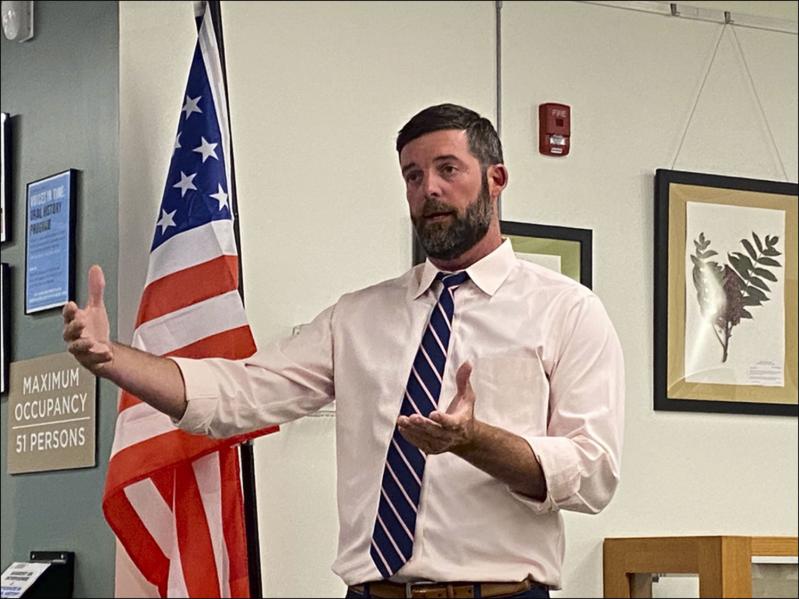Five months after Montauk voters rejected a $38 million capital bond for the district’s nearly century-old school, the superintendent and a member of the school board pitched a somewhat scaled back proposal that they plan to put to voters via a December referendum.
Josh Odom, the principal and superintendent, and Nick Finazzo of the school board told members of the Montauk Citizens Advisory Committee on Monday that the new plan reduced the cost by 10 percent and would not exceed $34.8 million. “It’s still a large number,” Mr. Odom said. “Of that I’m very aware.” In attempting to find savings to present a scaled-back proposal to voters, “we quickly found ourselves at $30 million.” But much of the building, completed in 1927, is aging, he said.
School district officials originally planned to repurpose the existing gymnasium into a performing arts space; construct a new gym with a greenhouse and bathrooms; renovate the school’s library, and address a range of other maintenance and repair issues had voters approved the $38.4 million bond. While the school’s $24.56 million budget easily passed in
the May 20 vote, the bond vote failed, with 318 in favor against 361 opposed.
Under the scaled-back plan, a new building housing a gymnasium would be constructed, as would a new science classroom and greenhouse, both replacing the existing ones. A new science classroom “is going to help our students be ready when they get to the high school,” Mr. Odom said. At 698 square feet, the existing science classroom is too small, he said after the meeting. “When you have 17 to 20 kids in there trying to run a science experiment, it can get a little tight.”
The existing gymnasium, which doubles as an auditorium, lacks air-conditioning. It would become a “music space,” Mr. Odom told the committee. “We have no space for music instruction right now — they learn on the stage.” The existing gym/auditorium “could be segregated to a multipurpose-room space as well as music instruction,” he said, also serving as a lunchroom. The “portable” classrooms constructed in 1972 would be demolished.
“We’re looking for a lot of structural upgrades in the building,” he continued, including to heating, ventilation, and air-conditioning systems. The school presently has an annual repair budget of around $300,000, though it is not always used in full. Americans With Disabilities Act compliance would also be improved by the proposed project.
“This plan actually addresses a lot more aspects of the building than the previous plan did,” Mr. Odom said. “It addresses a lot of the issues that we’re facing. It’s a little more expansive as far as the scope it touches within the building, something I’m really happy about.”
Robert R. Fisher, a former longtime principal of the school, and his wife donated a nearby residence on South Dewitt Place to the district. The structure is unoccupied at present and used for storage, and the plan is to demolish it and build a new structure to be used both for storage and as the principal-superintendent’s residence. This adds between $400,000 and $500,000 to the project’s new price tag, Mr. Finazzo said, but storage “is badly, badly needed,” a need that would become more acute with the demolition of the portable classrooms. Existing storage units behind the school building are dilapidated and in need of replacement, he said.
“That’s an awkward one for me,” Mr. Odom, who does not live right now at the residence, told the Montauk Citizens Advisory Committee, “as it’s a part of my contract there. It was my recommendation to the board to actually remove that and deal with it later. However. the board felt . . . it was important to utilize that building.”
In Mr. Odom, “we currently have a very talented man who’s able to fill that role, who will not be able to fill it forever,” Mr. Finazzo said. “My thought, at least, was, if we can offer this as a way to get the best possible candidate for our students and for our school and for our community, we have to utilize that asset which we already have.” Mr. Odom “did everything he could to try to get rid of the residence, over and over again,” he said. “I simply said ‘no,’ because I thought it was necessary.”
Maintaining the school’s aesthetic appeal is also important, Mr. Odom told the committee. “Montauk School is beautiful. We do not want to mess with the outside at all,” he said. The removal of one component of the original plan would help further that objective: construction of what Mr. Odom described as a small outdoor amphitheater-classroom would have extended onto the front sidewalk by about a foot, he said, changing the facade, “which we were all uncomfortable with.” Its removal from the project helped to realize “a significant savings” in the new plan’s overall cost. “We want it to be that beautiful building that we love.”
Mr. Finazzo acknowledged complaints from the community as to a lack of communication from the school district with regard to the previous proposal, “so you will see a lot more fliers, a lot more mailers going out, so communication is maybe more readily available than some of the ways we presented it last time.”
Should the bond referendum pass, plans would be submitted to the State Education Department, which would undertake a review of four to nine months. The district could then solicit bids, Mr. Odom said.

